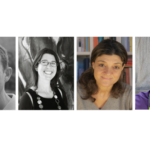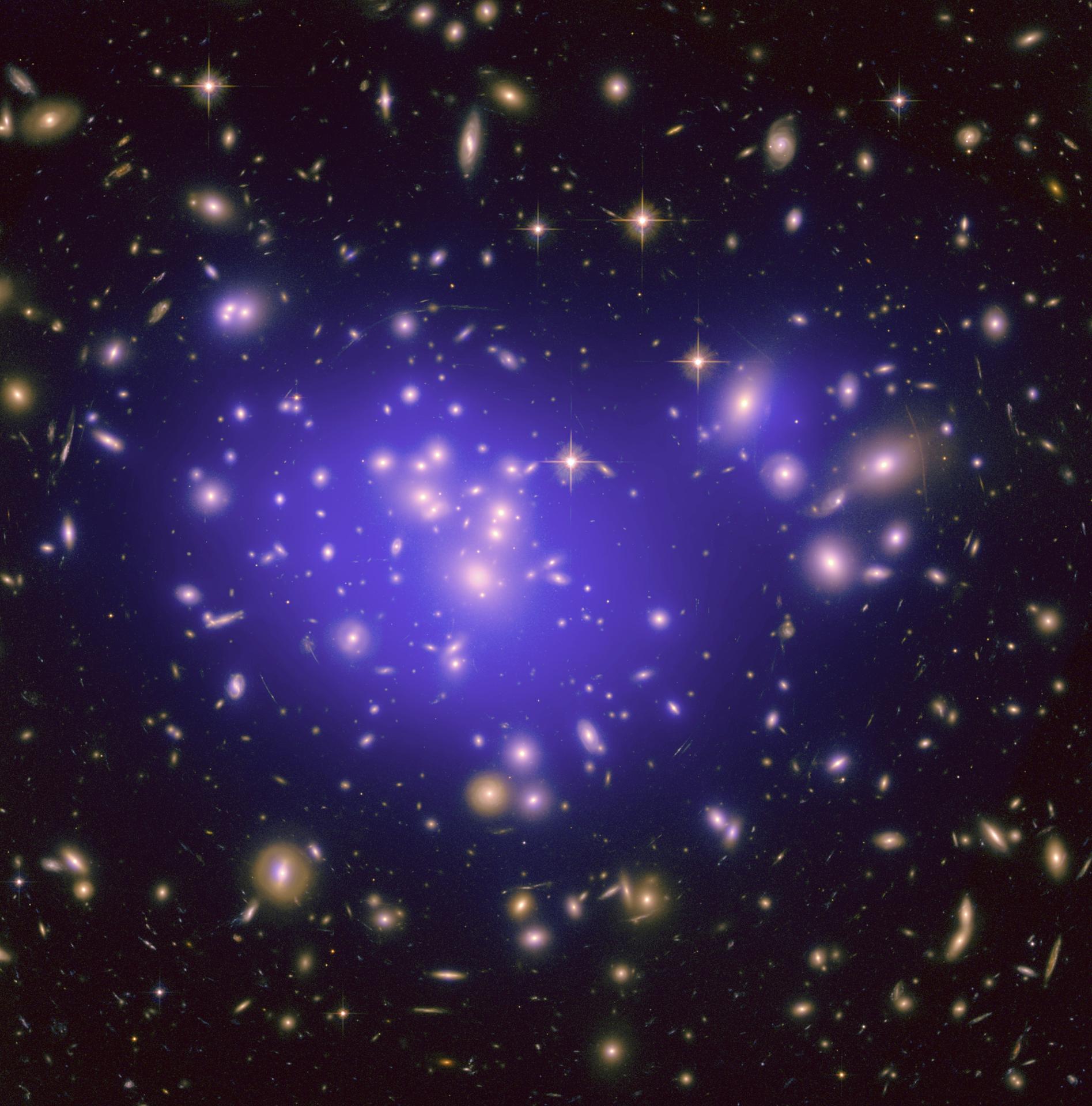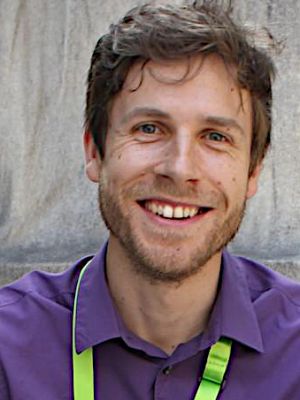
iDMEu – an EoI gathering the dark matter community
Interview with Marco Cirelli, Caterina Doglioni, Gaia Lanfranchi and Florian Reindl
In October 2019 the first Joint ECFA – NuPECC – APPEC Seminar (JENAS) took place in Orsay, close to Paris, where a call has been issued for novel Expressions-of-Interest. Following this call a group of Dark Matter scientists have drafted an open EoI to gather the broader dark matter community. Among others (see full list here), Marco Cirelli, Caterina Doglioni, Gaia Lanfranchi and Florian Reindl initiated the “Initiative for Dark Matter in Europe and beyond: Towards facilitating communication and result sharing in the Dark Matter community (iDMEu)”. In this interview they present their ideas and aims for this EoI.
You are working in various countries and experiments. Where and how did you come up with the idea for the EoI?
Florian: The idea of this EoI was born at the JENAS meeting, which took place in October last year in Orsay.
Marco: Yes, although I knew many of my colleagues from previous meetings, the JENAS workshop was just the concrete occasion that allowed us to meet in person and the idea of an EoI to emerge.
Florian: The main spirit of this meeting was the wish to strengthen the bonds between the different communities, working on fundamentally different approaches to detect DM (e.g. direct, indirect and collider searches, but also fixed-target, beam-dump and dedicated axion/ALP experiments). We are all working on dark matter in different countries, for different experiments and in different communities, but agreed that even in the dark matter community a common “platform” to share ideas, data etc. is missing. This was the starting point which evolved in the EoI.
Caterina: We see this EoI as a platform to bring together different existing efforts. An effort is, for instance, the LHC Dark Matter Forum / Dark Matter Working Group, where LHC theorists and experimentalists are connecting LHC results on WIMPs to direct and indirect detection experiments. In the LHC community there is also a growing wish to expand the DM menu beyond WIMPs, both conceiving new models and finding new experimental signatures.
Gaia: When we first discussed in Orsay, I immediately understood the importance of the initiative and I supported it. For me it represents the natural evolution of my activity within the Physics Beyond Colliders (PBC) study group. The PBC was launched by the CERN management in 2017 with the aim to investigate the potential of the CERN accelerator complex and scientific infrastructure for projects aiming to answer the same fundamental questions as those at colliders but requiring a different type of beams and experiments. To investigate the nature of DM beyond the WIMP paradigm was already part of this effort. The PBC study group gathered together colleagues from collider, beam dump, fixed target, axion/ALP experiments, and astroparticle to explore synergies and complementarities of different theoretical and experimental approaches.
What are your aims and how you want to realize them?

This image shows the galaxy cluster Abell 1689, with the mass distribution of the dark matter in the gravitational lens overlaid (in purple).(Credit: NASA, ESA, E. Jullo (JPL/LAM), P. Natarajan (Yale) and J-P. Kneib (LAM))
Florian: Nowadays, dark matter is commonly accepted as one of the fundamental open questions of physics. Therefore, we see the community quickly growing and approaching the dark matter problem from very different angles experimentally like theoretically. The result is a very active and lively, but also very diverse community. The idea of the EoI is to bring all those people together to take full advantage of all we “know” about dark matter already and to also make full use of cross-links for future work. The EoI is intended to show that there is a broad interest of the actors in the field to actually do this. It is also meant as a basis to jointly work on a concrete implementation.
Gaia: The origin and nature of DM is one of the deepest mysteries in particle physics today and we need to attack this problem from different fronts. Theory wise, we need to understand which other relevant hypotheses about the DM nature should be considered beyond the standard WIMP paradigm and how these hypotheses fit into a general theory framework. Two prominent examples are, for example, axions with masses in the micro-eV range or light DM with thermal origin in the MeV-GeV range. Experiment wise, we need to identify synergies and complementarities across different experimental approaches in order to enlarge the exploration as much as possible while optimising resources. In order to pursue these goals, first of all we need to develop a “common language”, which means to identify a common theory framework: theoretical and experimental physicists need to talk together in order to identify motivated benchmark models which could be tested experimentally. A first step in this direction was done within the Physics Beyond Colliders activity and allowed us to put together results from a wide variety of experimental efforts. This framework could be further improved with the help of the particle and astroparticle theory community and more experimental results can be included.
Caterina: Because we know so little about the nature of dark matter, I am keen to try to keep pursuing it from all directions. My own direction is the LHC, and I want to collaborate as much as possible with all others, experimentalists and theorists, who can point the community in the most promising directions towards a discovery. Since one of my passions at work is data acquisition and computing, I am also keen to connect the work of this initiative to that of the HEP Software Foundation, which facilitates collaboration and sharing of software; and to the ESCAPE project, a multi-collaboration effort across particle and astroparticle physics that aims to establish a collaborative cluster of scientific infrastructures that work together on Open Science implementations of our research tools.
Marco: I am a theorist, so I don’t work in any specific experimental collaboration. But as a theorist, I pay a lot of attention to results achieved by my experimental colleagues. The search for Dark Matter in recent years has literally boomed and expanded in a myriad of interesting directions, with many new theory ideas (at different mass scales, embedded in different frameworks or simply standalone) and many new experimental setups (ranging from tabletop to full-fledged international collaborations). This ‘explosion’ is of course positive and incredibly exciting, but also needs to be somewhat framed and patterned in order to be more efficient. To realize this, we want to rely on the work already produced in the different communities. We want to act at the ‘human relations’ level (conferences, meetings, cross-talks) and at the technical level (online repositories, sharing of results, common services).
You already have more than 200 endorsers. Do they represent the Particle-, Astroparticle- and Nuclear Physics Community? What are their main interests?
Florian: We have endorsers from all communities and also from experiment and theory. I would like to note that this EoI was born in Europe, but the EoI is not restricted to Europe and we find supporters all over the world. What brings us together is to solve the puzzle of dark matter.
Gaia: Within the signatories I recognize the names of friends, colleagues, and distinguished physicists belonging to the three communities with a very broad spectrum of interests, from collider physics, to DM direct and indirect detection experiments, flavour physics, gravitational waves, and particle and astroparticle theory. I do believe that this excellent and broad mixture of different expertise will strengthen the EoI program.
Marco: In addition to the different scientific backgrounds, I can also recognize among the endorsers people at different career stages, ranging from some of the senior policy makers of the field to young postdocs and some PhD students. This, I think, is very healthy and shows the grassroots nature of the initiative.
Gaia: We are living a period of confusion in particle physics, old paradigms seem to be inadequate to answer fundamental questions, and new ones are still to be defined. Nevertheless I have seen in the last few years an increasing interest from people belonging to different communities to cross boundaries, talk together, exchange ideas and results, towards the common goal of understanding fundamental laws of Nature. Nature is the same for everyone. This EoI is the expression of an already existing and widespread movement in this direction and that is why it is getting a large support.
Marco: The diverse scientific interests and backgrounds are in a sense natural, since the Dark Matter problem is by its very nature transdisciplinary. In another sense, this also shows that many sub-communities are perhaps restructuring themselves in this period and that many colleagues that were working on other subfields are now reorienting their research towards Dark Matter.
Caterina: One of the key points of this initiative in my opinion is to be inclusive of everyone’s interests and voices. Many of these voices are already being heard in working groups where “expert work” is ongoing, such as DMWG and PBC, and we will rely on their work to set the direction and topics of the future steps. Even if we distributed the EoI link quite broadly, we may not have reached out to everyone who is interested. Therefore, this is by no means a “closed” list – we will turn this list of endorsers into a mailing list with an archive that will be on the indico page so that others can sign up along the way.
What do you expect that APPEC-ECFA-NuPECC organisations can do?
Marco: The organizations have already done a lot, just by making the interesting and highly non-trivial JENAS meeting possible, that spurted our initiative. By keeping the channels of communication open in between the communities (e.g. organizing other similar meetings, or providing logistical support to initiatives like ours) I think that these organizations can have a very positive role.
Gaia: We need help on several fronts. First of all, we need guidance from APPEC-ECFA-NuPPEC, to better understand what can be realistically done and with which priority. Second, the help of these organisations will also be invaluable to have this effort officially recognized in the Institutes of all active participants in order to:
- have a framework in which this proposal can be developed;
- get support for related activities (space/logistic/funding for meetings/conferences/workshops, setup of publicly accessible repositories where to store results/algorithms/webpages, etc);
- improve the communication in two directions:
- across the three scientific communities in order to spread information about events, discussions, and results,
- towards the general public in order to convey a common message and present our research progress as a common story, as truly is.
Do you think your work can influence the EPPSU, and if not this one, maybe the next?
Caterina: Some of us proposing this EoI had also already worked together on the Briefing Book towards the update of the European Strategy of Particle Physics, where we wrote an “Outlook on synergies” in the Dark Matter chapter reflecting the wish for closer collaborations between the astroparticle, particle and nuclear physics in terms of common search targets and common tools (e.g. experimental technologies, shared software repositories…).
Gaia: there is already a widespread and large movement in the direction of work across theory-experiment and across different communities. This movement cannot be stopped at this stage, but certainly can be better organized. I hope that the ESPPU delegates will not miss the opportunity to further boost the already lively and rich particle, astroparticle and nuclear physics communities.
Caterina: There were already favourable steps in this direction in the 2013 strategy, which have led to the creation of initiatives such as EuCAPT, an astrophysics theory centre within CERN, whose help we’ve been relying on for the hosting of this EoI and further initiatives.
Marco: I don’t think that initiatives like ours are meant to ‘influence’ processes like the EPPSU. In some sense, we are just aiming to deal with the day-to-day business of Dark Matter research in a more streamlined way (creating links, putting in place technical tools, facilitating communication…) rather than devising the broad lines of the strategy. We are bold enough to think that Dark Matter is already a clear crucial priority of our field, and we would like to make the process of searching for it more efficient.
Caterina: This EoI is meant to encourage communication within a platform that will help DM researchers in Europe and worldwide, and will have useful practical outcomes such as common repositories and shared outreach material.
What will be the next steps?
Florian: We have some next steps sketched at our indico page. I think the most important one is a kick-off meeting organized at CERN (with an available remote connection), which will be followed up by meetings at upcoming conferences and workshops.
Marco:The kick-off meeting will be an occasion to further understand the work that is already being done in many working groups aimed at structuring DM searches in different subfields. Then we will discuss the next steps with the community of endorsers.
Florian: We also plan to establish a common repository to share experimental data (or use existing repositories) coming along with frameworks for their theoretical interpretation. Also, we will from the beginning work together on public outreach, such as e.g. the international dark matter day.
Gaia: My personal opinion is that in a first stage we should rely on existing activities and facilitate communication among them. As far as I am concerned, I will further boost the work done within the Physics Beyond Colliders study group during the workshop FIPs 2020 organized at CERN in May 2020. At this meeting, we will discuss, among other topics, results and prospects for light DM and axion searches with a wide variety of experimental techniques and with the help of renowned theoretical and experimental experts in these fields. I know that a similar effort is being done within the DM@LHC workshop and I have been invited to their annual meeting in June 2020 at DESY to discuss possible synergies. We hope to be present at the APPEC, ECFA and NuPPEC town meetings and to establish an annual meeting of iDMEu.
Further reading:
- Initiative for Dark Matter in Europe and beyond iDMEu
- European Strategy update for particle physics: https://europeanstrategyupdate.web.cern.ch, Briefing Book
- LHC Dark Matter Working Group documents and activities: https://lpcc.web.cern.ch/content/dark-matter-wg-documents
- Physics Beyond Collider documents and activities: http://pbc.web.cern.ch/













